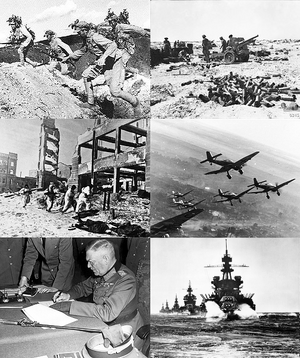World War II, also known as the Second World War, was the greatest conflict in humanity's history, lasting six years from 1940 to 1946. It involved the vast majority of the world's nations divided into two opposing alliances: the London Pact, also known as the Allies, led by the United Kingdom, the Greater Union of Russia and the United States; and the Axis Powers, led by France, the Confederate States, Italy and the Empire of Japan. These nations were in a state of total war, where the entire economic, industrial and scientific capabilities were used for the war effort. Between the massive campaigns and battles, genocides, and the only wartime use of nuclear weapons, and estimated 100 million, possibly even more, perished in the conflict.
The war is said to have begun with the invasion of the Low Countries by France in 1940 and subsequent declarations of war on France by the United Kingdom and Germany. For the following two years France conquered or was allied with most of continental Europe. With a loose alliance with Russia the two partitioned much of Eastern Europe, until 1942, when France launched the largest invasion in the history of warfare. Russia's continued resistance tied up most of France's forces, leading to the United Kingdom and its colonies being successful in other theaters, such as North Africa. In 1941, the Confederates invaded the United States and its allies, and in 1942, Japan attacked European territory in the Pacific, turning the war global. Other theaters included conflict in South America and southeast Asia.
The Axis advance stalled with Pact victories over Japan at Midway, over the Confederacy at Washington DC and Pittsburgh, and over France at Volgograd. Pact forces defeated France in North Africa, which led to the invasion of Italy and its surrender. Russia counterattacked and regained its lost territory. France, the Confederacy, and Japan was forced to retreat on all fronts. The Western London Pact liberated southern Germany, while Russia liberated northern Germany. The United States invaded the Confederacy, while Canada and Alyeska forced California to surrender. Japan suffered severe losses in China and southeast Asia, while the London Pact crippled Japan's navy and liberated key strategic islands.
The war ended in Europe with the Western London Pact invasion of France and their capture of Paris in early 1946, leading to the French unconditional surrender. Following the devastating March to the Sea Campaign and the capture of Atlanta, the Confederacy surrendered. When Japan refused to surrender, the Western London Pact dropped two atomic bombs on Hiroshima and Nagasaki, leading to Japan's surrender in August 1946. The London Pact had achieved total victory.
The world was forever changed. The League of Nations was founded to prevent future conflicts of this scale from breaking out again. The leading victorious powers - Russia, the United States, the United Kingdom, and China - beame permanent members of the Security Council of the League of Nations. Russia and the United States emerged as the two most powerful nations in the world, and began competing for global influence for the rest of the 20th century in the Cold War. The influence of Europe decreased as decolonization began, Political integration emerged in Europe as a way to solve problems and end pre-war enmity.
Background[]
Pre-War Events[]
African Colonization (1935-1938)[]
In 1935, Italy exposed the weakness of the United Nations by launching an invasion of the sovereign nation of Ethiopia. Despite fierce defense by the Ethiopians, the Italians would defeat them and conquer the nation, annexing it and incorporating it into the new Italian colony of Italian East Africa. The United Nations condemned Italy, but did little to prevent the conflict.
French North Africa had been forcibly separated from France in the aftermath of World War I. In 1937, Charles de Gaulle, emboldened by the Italian conquest wished to reunite Algeria with France, stating that he needed to liberate the French population which was oppressed by the new Muslim authority in the former colony. Following the policy of appeasement, Britain and Germany allowed France to retake Algeria in exchange for no further African expansion. The Muslim rulers refused to bend the knee to de Gaulle, resulting in a short bloody war over the fall. Showcasing the power of the modern and re-militarized French army, the Muslim defenders were brutally defeated, with multiple leaders being killed in bombing raids. The French power alarmed Britain and Germany, who were beginning to realize the long bloody war that would ensue if they fought France.
Appeasement Agreements (1938-1939)[]
Both in Europe and North America, the National Socialists were growing bolder and more aggressive. In the Confederacy in 1938, Black demanded the reunification of Oklahoma with the south. US President Samuel DeWitt, despite some of his cabinet urging him to take a stance, DeWitt agreed to hold a referendum in Oklahoma about returning to the south. An overwhelming majority supported the reunification, and DeWitt agreed to return for the area to be demilitarized. Black openly defied DeWitt, moving troops and tanks into the new Confederate state. DeWitt's failure would lead him not being chosen for a third term campaign, instead being replaced by hardliner Franklin Roosevelt, who promised a firm stance against the south.
In Europe, France re-militarized Champagne, directly next to the German border. Hoping for a final chance at peace, the British, Germans, French, and Italians met at the Lyon Conference of early 1939, where the National Socialists agreed to end their territorial expansion. Three months later, Italy defied the treaty by invading Greece and the island of Crete.
With this final act, Britain and Germany realized war was inevitable. With the French mobilizing their troops near Alsace-Lorraine and Belgium, the British and Germans ordered their own mobilizations, and pledged to support Belgian independence. Germany and Russia signed a non-aggression pact, so Germany would avoid a two-front war as in the previous conflict. Upon discovering the British and German pledge, de Gaulle demanded Belgium send diplomats to discuss "future territorial agreements". The Belgians refused, and de Gaulle gave the order to invade.
First Act[]
Invasion of the Low Countries (1940-1941)[]

French troops in Alsace-Lorraine
On September 13, 1940, France launched its invasion of Belgium and Alsace-Lorraine, resulting in the British and German governments declaring war on France the next day. The French claimed the Belgium had attempted to sabotage several French facilities, and that the Belgians should be punished. The French's tactic of "lightning warfare" or guerre éclair resulted in Belgium losing its capital in the beginning of October. Britain and Germany did little to help the Belgians, with Britain only mobilizing its armies, while Germany moved a force under Walther von Reichnau to its border. With this quick capture of Belgium, Charles de Gaulle hoped to sign an armistice with Germany and Britain to give France more time to prepare, but both Britain and Germany refused to an armistice "until the full sovereignty of Belgium was restored." De Gaulle and his generals decided to wait until spring to commence their invasion of the Netherlands and Germany. During the wintertime, Reichnau's corps was sent to the Netherlands. The Westwall Defensive Line established between Germany and France by the Germans underwent construction to continue it along Belgium.

French soldiers marching to Metz
In March 1941, the French blasted through the uncompleted Westwall and a German force in the Hurtgen Forest in the first major battle of the war. The Germans were taken completely off-guard, expecting the "same, slow tactics the French always used," as Reichnau wrote. The fortress of Metz was taken, resulting in the collapse of most German troops in Alsace-Lorraine. Bypassing the German defenses in the Ruhr industrial area, the French raced north through southern Belgium capturing the major German seaport of Emden by April. The French movement had surrounded the entirety of Holland, which the French invaded shortly after. With the French armies coming from all directions but but northwest, Reichnau hoped to break out of the pocket and return to Germany. The Germans met the French at the small Holland town of Winterswijk. Reichnau's forces were soundly defeated, and retreated to Amsterdam, which the French where approaching rapidly.
French submarines destroyed and scattered the British Navy stationed outside Amsterdam, preventing any sort of evacuation from there. An evacuation was held farther north, at Het Bildt. There, much of the German army and equipment was quickly evacuated by the Royal Navy. Reichnau stayed behind, to defend Amsterdam. The Battle of Amsterdam, from May 2nd-4th, resulted in Reichnau's surrender and the capitulation of Holland. With the Low Countries secured by the French, it could now use all of its might to attack Germany.
Advance into Germany (1941)[]
Germany, with Reichnau's catastrophic defeat in Holland, now recognized the seriousness of the French army. The French, fresh off their victory, moved their troops in from the north to capture the industrial Ruhr area, with a secondary army sent to capture the bridges and dams of the Rur River, with the goal of capturing the city of Dusseldorf. French lightning warfare succeeded once more, as their fast moving tanks blasted through the unprepared German defenses, while French infantry mopped up the remaining resistance. In a spectacular German defeat, Dusseldorf was captured and thousands of Germans were taken prisoner. This opened up the entirety of the Ruhr to the French. This would be a huge blow to Germany's war effort, and was made worse when the Polish rose in rebellion shortly after, with Warsaw taken by July by the Poles.
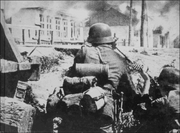
Urban fighting in Dusseldorf
Germany hoped to defeat the French, then deal with the Poles. A major offensive under German commander Erwin Rommel occurred in July, with the goal of punching through French lines in northwestern Germany and liberate Belgium by capturing the important port of Antwerp. The Germans put behind the majority of their manpower, armor, and aircraft into the Rhineland Offensive. The French were initially surprised by the ferocity of the German offensives, and part of the Rhineland front nearly collapsed, as the French were even pushed back into Belgium. With the seven roads of the Ardennes all converging in the Belgium town of Bastogne, the French put up a brave defense there. After a week of heavy fighting around Bastogne, the French forces were relieved. French tank divisions eventually surrounded Rommel's forces in a pincer movement, and closed in on Rommel's forces, who were running out of steam. At the Battle of Bure, Rommel was killed, and German forces surrendered. The Germans had lost the majority of their manpower and equipment in this offensive, and with Russia invading the new "Polish Republic" Germany's defeat was inevitable. Delaying actions in western Germany allowed the government and parts of the army to escape by evacuating at Rostock. German president Wilhelm Groener personally surrendered to Charles de Gaulle in late August as French forces entered Berlin unopposed. The first major phase of the war had ended with French victory. The Rhineland and northwestern Germany were to be incorporated into the French empire, along with Berlin. A new, collaborative German government was declared, the new Protectorate of Austria, led by German politician Adolf Hitler. The French prepared to consolidate their gains as they planned the next phase of the war. While the French paraded their glorious triumph, the London Pact pointed out the Rhineland Offensive, which proved the French weren't invincible.
War Opens in South America (1941)[]
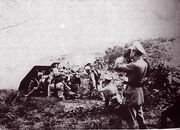
Colombian artillery during the invasion
The devorist powers in South America began their own operations. Colombia demanded that Peru vacate its northernmost provinces, which had been in dispute between the two countries since their independence from Spain. Peru refused, and a military build up on the border began. Simultaneously, Argentina mobilized and would invade Uruguay in March 1941, bringing the war to South America. Montevideo was captured within a week. When Argentina refused to vacate the occupied Uruguay, Brazil and it's London Pact allies Bolivia, Venezuelua, and Peru declared war on Argentina. Colombia and Chile declared war as well, and Colombia launched its invasion of Peru.
The Axis nations of South America had followed the lessons of their European counterparts, and relied on the strategy of an extremely mobile attack that could defeat larger nations before they were even ready to fight. Brazil, the largest nation and nominally the leader of the South American Allies, had a woefully underequipped and unprepared army that was still using weapons and tactics from the First World War. The Argentine army smashed through the Brazilian lines and marched north to capture the Brazilian center of power in Sao Paulo and Rio de Janiero. Sao Paulo fell by June, but Brazil would hold steady at Rio for the time being. The modernized Argentine navy dealt a crippling blow to the Brazilian navy and disrupted Brazilian trade with the rest of the Allies.
Colombia struck quickly as well, capturing border villages easily. The Axis powers quickly established air superiority over the Allies, with large scale bombing raids striking the Peruvian capital of Lima and Rio de Janiero. The Axis hoped to defeat Peru by surrounding it, with a joint Chilean-Argentine force heading to capture Tacna. Bolivian reinforcements to the city ultimately rescued it after a long battle; a reverse of what happened earlier in the War of the Pacific. The Axis powers had momentarily been delayed, but they were still ultimately winning the war as their troops advanced in northern Peru and southern Brazil.
The Mediterranean Conflict (1941-1942)[]
With their attempt at conquering Greece ending in failure, Mussolini ordered an invasion of the Kingdom of the Balkans instead. Italian forces landed in Albania in October 1941. 100,000 men and 600 airplanes was the initial invasion force, landing at the major ports of Albania. Albania's Governor, Ahmet Muhtar Zogolli, fled Albania, and Italian forces overcame local patriot and resistance forces. The government of the Balkan Union planned on surrendering Albania and willingly joining the Axis Powers. However Peter II, the 17 year old King of the Balkans, declared himself of age and participated in a coup to take control of the government. Peter II refused to surrender and mobilized Balkan forces. Despite the fact the majority was under-trained and under-equipped, the Balkan forces smashed the Italian army in several battles in November 1940, and retook the Albanian capital of Tirana.
Charles de Gaulle feared an Italian defeat would give the British dominance in the Balkans and the ability to threaten the Romanian oilfields the French military relied upon. Threatened with the might of the French Army, Hungary, Bulgaria, and Romania joined the Axis Powers. In December, the Axis Powers simultaneously invaded the Kingdom of the Balkans and Greece. The French Air Force obliterated the Balkan planes in their airfields, and their mechanized infantry and tanks destroyed the outdated tanks the Balkans possessed. Hungary and Italy launched offensives a few days later, but by then the Balkan army had cracked and was in full retreat. As King Peter and the government evacuated the country, the French conquered Belgrade and the Royal Balkan Army had surrendered. German troops then overran the defenses at the Greek border, pushing into Greece and conquering the nation within a month.
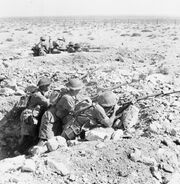
Australian forces at the Battle of Tobruk in 1942
At the same time, Italy began operations in Africa, conquering British Somaliland and invading the British colony of Egypt in October of 1941. In January, the Imperial Commonwealth launched their counterattacks, dislodging the Italians from Egypt. Italy would suffer several disastrous defeats, losing eastern Libya and a good number of troops were taken prisoner. The Royal Navy destroyed the Italy Navy in several naval battles off the coast of Italy. French intervened to save the Italians, landing troops in Libya in March. In June of 1942 the Commonwealth was forced out of eastern Libya, except for the port of Tobruk, which was held by the Commonwealth despite a lengthy siege by the French.
War Opens in North America (1941-42)[]
As the war in Europe raged, there was a tense calm in North America. Hugo Black had hoped that the United States would continue to appease him, but the election of Franklin Roosevelt in the United States brought an end to that. Roosevelt had a firm stance against the Confederacy, and in April of 1941, gave the Confederates the order to follow the terms of the Treaty of Portsmouth and reduce the size of their military. The Confederate government remained quiet, until on the morning of May 4, 1941, they launched the massive Operation Lee: the invasion of the United States.
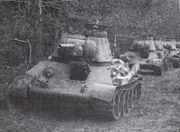
Confederate tanks blitz across Kentucky
The Confederacy, along with its ally California, launched three offensives into the United States. Army Group Longstreet under command of General Patton was sent to take control of Kentucky, which would cut off the United States from its new western seaports. Patton had studied French lightning tactics, and used it to great success, defeating the first major American garrison at Frankfort by mid May. Patton, an aggressive commander, attacked with such speed it blew past American defenses. By the end of June, the major city of Louisville was taken, and the United States was cut in half. In the west, the Californians under General Earl Warren were sent to capture Crescent City, the largest city and harbor the Americans possessed on the west coast. Warren's troops prevailed by winter, with the exhausted American troops running out of supplies. In the east, Army Group Stuart under General Holland Smith was sent to capture the major population centers of the United States. With their lives and families threatened, millions of Americans rallied to join in the defense of their nation. The Battle of Bull Run from the end of May to mid-June was a victory for the Confederates, but it had cost them over 3000 troops, and gave the North enough time to regroup in Washington DC. Black gave the order to Smith to capture the city and raze it to the ground.
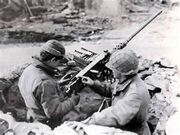
Union soldiers in a machine gun nest at the Battle of Washington
The Battle of Washington lasted half a year, from July to January, as both sides put a major effort into the control of a rather symbolic target. President Roosevelt stayed in Washington DC in a bunker near the White House, where he rallied the American troops to defend the city. Much of Washington was destroyed in the heavy street fighting as every street and building was contested. The lightning war Black hoped for along the eastern seaboard failed, and both sides entered a stalemate. The Confederate attempt at establishing air superiority around Washington failed, and bombing was reduced to night time only due to fighters and anti-aircraft guns. With Washington a stalemate, Smith attempted to encircle the city by sending troops to capture Baltimore, which was north of DC. Smith's attack failed to dislodge the stubborn American defenders, who, with thousands of reinforcements, mounted a counterattack. The western wing of Army Group Stuart failed to keep control over important bridges over the Potomac, which were retaken by the Union. On Christmas Day, 1941, the Union 5th and 6th armies crossed the Potomac and encircled the Confederates inside the city. The southern armies there were annihilated, and the remaining members of Army Group Stuart regrouped at Bull Run to fight a defensive war the Confederates were not prepared for.
The Pacific Front (1942-1943)[]
With French successes in Europe, Japan decided to increase its pressure on European colonies in Asia. Britain and the German government in exile decided to end all trade with Japan in May 1942, with Australia, New Zealand, and Canada joining them in the following weeks. Alyeska, feeling threatened by the Japanese, joined the British colonies in the embargo in June. Several necessary Japanese resources, such as oil, began to run out as shipments ended. Negotiations between the powers began to break down, as the Japanese promise of ending further invasions in exchange for oil was not taken seriously by the London Pact, and Japan absolutely refused the Pact's demand of ending their campaigns in China to get the resources they needed. In order to continue their conquests of Asia, the Japanese would have to conduct a much larger scale war. Japan planned on rapidly taken the colonies and resources it needed, while fighting a defensive war to the death with the overstretched Pact nations. What the Japanese didn't take into effect was whether they overstretched themselves.

Japanese bombing of the British fleet in the Sandwich Isles
In order to gain the initial advantage over the Pact members, Japan decided to neutralize their navies, many of which were in port at the time. On December 8, 1942, Japan launched a series of massive offensives all across the Pacific. The Royal Colonial Navy, stationed in the Sandwich Islands, was destroyed in an attack; Alyeskan army and navy bases in the Aleutian Islands were targeted and troops began to land on some of westernmost isles; landing were undertaken in German Indochina, and Hong Kong was assaulted and taken. The Japanese failed to neutralize the Canadian fleet, which wasn't in Canadian ports. In response, the London Pact declared war on Japan, fully turning the war global.
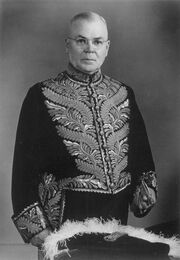
Canadian Admiral and Supreme Commander of Pact Pacific Forces William John Patterson
With the Pact armies stretched thin in Europe, little resistance could be put up against the Japanese offensives. Alyeska and Canada took charge, with Canadian general and future Prime Minister William John Patterson being named Super Commander of Pact Forces in the Pacific. Patterson was given a large force, but incredibly spread out. In 1943, Japan launched a second series of offensives across the Pacific and southern Asia. Pact forces made a valiant last stand at Singapore, but the Japanese eventually overwhelmed the defenders and took thousands of prisoners. In the Battle of the Java Sea, the Japanese Navy struck a significant blow against Pact navies, and led to the occupied of the East Indies.
Japan hoped to blockade and isolate Australia and knock them out of the war. With Australia sending most of its troops to support the British in North Africa, it was incredibly vulnerable. Patterson boldly declared "the Pact will never allow Australia to fall". The Japanese launched bold air raids at northern Australian targets, including a devastating strike on Darwin that resulted in nearly 400 deaths. Patterson's code breakers discovered the Japanese planned an attack on Port Moseby, giving the Japanese control of the seas surrounding northern and western Australia. While Aleyskan ports worked to build a navy, the Canadians sent two of their own carriers: the MacDonald and the Vancouver, to stop the Japanese advance. The Battle of the Coral Sea, was a decisive Japanese victory, with their aircraft destroying the MacDonald and damaging the Vancouver. However, several Japanese ships were damaged as well, which would come back to haunt them at the Battle of Midway. The Pact had achieved their first victory in the Pacific by preventing the Japanese blockade on Australia.
Invasion of Russia[]
Second Act[]
The Outskirts of Moscow (1942-1944)[]
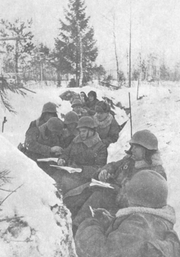
A Russian trench near Moscow
France had made great gains into Russia by the end of fall of 1942. However, France had run out of steam as the winter set in. France was ill-prepared to deal with the winter, as they had wished to capture Moscow by this point and knock Russia out of the war. With heavy fighting in the Moscow suburbs, France had reached a nearly insurmountable wall of defense. After signing a non-aggression pact with Japan, Trotsky had shipped in fresh troops from the east, while new factories in the Ural Mountains produced guns, tanks and equipment rapidly. The French had stretched their supply lines too far, and from here the tide would turn against them. By the end of January, the freezing and exhausted French troops were pushed out of Moscow.
Marshal Georges and Trotsky's new Supreme Commander, Georgy Zhukov, attempted to outwit each other in a series of battles near Moscow and the surrounding territories. Konev's counterattacks had mixed success, with the French resisting most of them throughout the spring of 1943. Konev's forces managed to punch a hole between Army Group Central and Army Group South, and attempted to encircle Army Group South with incoming troops of the Second Georgian Army from the Caucasus Mountains were foiled when the French Fourth Army prevented them from crossing the Don River. The Second Georgian Army retreated to the major city of Volgograd. The French Fourth Army also set their sights on this city as well.
The French decided to refocus their offensive; instead of marching on Moscow, Marshal Georges reassigned many troops to Army Group South, who made a push toward the Caucasus Mountains to secure major oil fields. The major parts of Army Group South, the French Fourth Army and the 1st Mobile Division, reached Volgograd in early September. Alongside the French were two Romanian divisions that were placed to either side of the French to free up French troops for the main offensive.
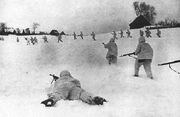
Russian infantry during the encirclement of Volgograd
The Battle of Volgograd commenced, the bloodiest battle of the war. Ivan Konev led the valiant Russian defense in Volgograd, where bloody street-to-street fighting occurred and every building was fought for. The Romanian armies failed to secure the major bridges, allowing a Russian counteroffensive in the middle of the harshest winter of 1943-44. Konev's armies pushed through the Romanian armies and encircled the French troops trapped in Volgograd. A majority of French troops were annihilated as the Russians retook the city. French attempts to start another offensive toward the city failed, and with Army Group South utterly devastated, the path to Ukraine and eventually the rest of Europe was opened.
Patterson's Plan (1943-1945)[]
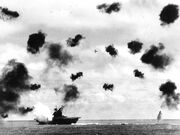
Battle of Midway
Japanese commander Yamamoto planned to destroy the remaining Pact fleet by luring it into a trap at Midway Island. The Japanese believed Patterson only had the Vancouver still, but they failed to account for an Alyeskan reinforcement fleet consisting of two carriers, the Yukon and the Sitka. The Japanese failed to discover this fleet, allowing the Alyeskans to flank their fleet. On June 4, 1943, the Japanese fleet arrived at Midway, and Yamamoto began the assault. He planned to destroy the remaining Pact fleet and conquer the island, giving the Japanese control of the Central Pacific. Along with a conquered Aleutian Islands, the Japanese would have a massive defensive perimeter in the Pacific. However, the Alyeskans repelled the Japanese assault a month after they landed.
While the Japanese Zeroes and American planes fought near Midway, the Alyeskans launched their surprise aerial ambush, along with torpedoes. While this assault was largely ineffectually, it forced Yamamoto's four carriers to scatter and become disorganized, and with the Zeroes focused on the Alyeskan fighters, high flying Canadian bombers could outmaneuver them from above and drop their bombs. The Canadian navy launched a counterattack, launching a full arsenal of torpedoes and another wave of planes and bombers. Three of the four Japanese carriers were crippled and destroyed, with the only major Pact loss being the Sitka. Yamamoto decided to pull out, with Japanese power checked once again.
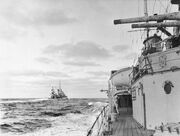
Canadian cruiser Achilles during a raid on the Malaita supply lines
The loss of much of the Japanese fleet forced them to go on the defensive. Patterson announced his new plan "island-hopping", better known as Patterson's Plan. The Plan was to avoid heavily defended Japanese controlled isles, and instead take over less defended islands as they made their advance to Japan. Patterson decided to start with the Solomon Islands in the southeast Pacific, and relieve pressure on Australia. The Japanese were building a major airbase on Malaita, which led to a combined Canadian/Alyeskan army of 15,000 assaulting the island. Heavy fighting in the lagoons and jungles occurred, with the Pact eventually taking the airfield. The Japanese launched continuous assaults, resulting in severe casualties that they struggled to replace. Patterson's navy began to attack the supply lanes the IJN used, destroying or crippling many ships the IJN could not easily replace. Running out of supplies and reinforcements, Japan decided to retreat from Malaita, giving the Pact a major victory.
Patterson's Plan was now in full swing. The industrial might of Canada and Alyeska was used to built weapons, planes and ships, and easily outproduced the Japanese, which lacked an industrial base of their own. Islands began to fall one by one during 1944 and 1945, as the Pact neared closer to Japan. The Pact perfected the art of the amphibious assault, learning from mistakes like the one at Tarawa in 1944, which cost the Pact a lot more troops than necessary due to failures in planning.
North Africa and The Return[]
Patton's Charge (1941)[]

Operation Lee. Grey is the first Confederate phase, red is the first Californian phase, green is the only part of the second Confederate phase to occur
With the lightning campaign along the eastern seaboard failing to capture a quick victory, Black and the Confederates realized they needed to win another set of major victories to potential knock the United States out of the war. Army Group Longstreet under General Patton was ordered to head east and capture the industrial midwest of America, with the biggest victory being Pittsburgh. Black hoped that eventually Army Group Longstreet and Army Group Stuart would meet up and encircle America in a massive pincer movement. Correctly believing Quebec was aiding the United States by allowing the United States military passage through their territory as well as allowing war supplies to pass through, the Confederates declared war and Patton invaded Ohio. The Quebec government vowed to return fire and now let the attack go unpunished, resulting in Quebec entering the war. Confederate bombing raids also attempted to prevent supplies from reaching the west of America.
After barreling through Ohio, Patton and Army Group Longstreet reached Pittsburgh. American colonel George Price Hays rallied the 10th Division to defend Pittsburgh until reinforcements arrived. Army Group Longstreet attempted to encircle the city, but Hays' destruction of several bridges prevented the Confederates from crossing two rivers to fully encircle the city. The Americans held the high ground on the hills near Mount Washington, and continued to reign artillery and gunfire down upon the Confederates. Patton, aggressive as always, ordered "Patton's Charge" up the hills. The highest point on the hill is regarded as the High-Water Mark of the Confederate States. With a massive rate of casualties, Patton was forced to call off the charge, and the Confederates settled into a defensive battle similar to the one in Washington DC.
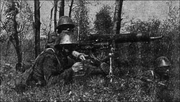
Confederate soldiers manning a machine gun at the Battle of Portsmouth
American reinforcements and supplies resulted in the Americans gaining an upper hand in Pittsburgh. Not wanting to have the same fate as Army Group Stuart, Patton and Army Group Longstreet abandoned the city and retreated into Ohio. Patton defeated the Quebec in the Battle of. Afterwards, Patton set up a defensive line along the Scioto and Ohio Rivers, and hopefully waited for incoming Confederate forces. Before reinforcements could arrive, Hays arrived with a large force of infantry and tanks. The first initial wave of American attackers attempted to cross the river under darkness was repelled, resulting in Hays encamping on the other side of the river, while, unknown to the Confederates, the Quebec 1st and 2nd Armies along with tank divisions marched around the Scioto River. Confederate scouting parties reported the incoming massive force, and Patton attempted to flee, only to be caught by a third American force under General George Marshall waiting on the other side of the Ohio River. Army Group Longstreet was crushed in the Battle of Portsmouth, with nearly a third of the force becoming casualties. Patton and his remaining forces regrouped on the other side of the Ohio River, and chased by American forces, retreated to Louisville.

